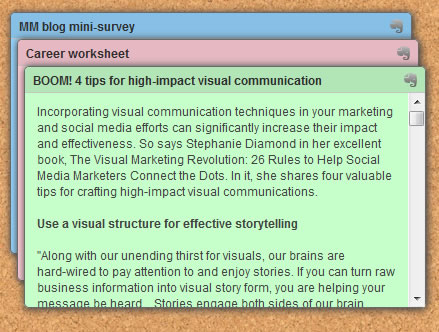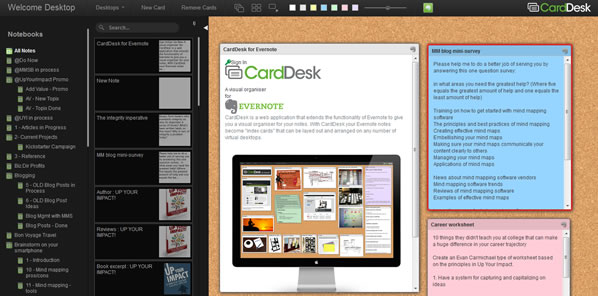An innovative developer in the LinkedIn Evernote group has announced a new beta web application called CardDesk that enables you to drag and drop your Evernote notes onto a canvas or workspace and display them in relation to each other.
CardDesk, developed by Ashley Rawbone, treats each one of your notes as index cards, which may be moved, resized and color coded. Cards can contain images and links to documents and web pages. You can even add new notes using Evernote’s web interface. Rawbone says he’s working on a “quick note” feature that will enable you to open a new index card within CardDesk, eliminating the need to do so within Evernote’s web application.
This visualization tool, which is still in beta testing at the moment, can be used to create vision boards, map out project requirements and display research you have gathered for reports. It may also be useful for group brainstorming, if you use a projector to display the CardDesk desktop on a large screen.
When you first open CardDesk, it asks permission to integrate with your Evernote account. It then quickly displays its contents in a slide-out panel that displays your Evernote notebooks and your notes side by side, in reverse chronological order. The notes panel has a search box, so you can filter your large database of Evernote notes to a manageable handful, based upon your search criteria. You currently can’t view or search your Evernote database by tags, but I suspect that will be added in a future update to CardDesk.
 Adding content to your desktop is as easy as dragging and dropping from the notes panel to the workspace. The Evernote data panel can be pinned open; when not in this state, it slides out of the way when you’re not using it, giving you a large amount of space in which to work. This is one application where you’re going to want to maximize the size of your browser window!
Adding content to your desktop is as easy as dragging and dropping from the notes panel to the workspace. The Evernote data panel can be pinned open; when not in this state, it slides out of the way when you’re not using it, giving you a large amount of space in which to work. This is one application where you’re going to want to maximize the size of your browser window!
New cards can be added to CardDesk’s canvas and any notes you have dragged and dropped from Evernote may be removed if you decide you didn’t need them after all. Notes can be stacked or tiled. These commands enable you to create neat rows and columns of notes and to group them in space-saving collections, respectively. You can create multiple desktops within CardDesk, which means you can assign one to each project you’re managing. One Evernote note can exist in multiple desktops within CardDesk, and can even be colored differently.
What’s all the excitement about?
In my opinion, CardDesk solves a real need for Evernote users. If you’re like me, you may have thousands of notes in your Evernote database. The only way to view related notes together is by conducting a search or viewing all notes that contain a certain tag. The filtered results are displayed in 1 or 2 columns or in a tabular interface – but they can’t be rearranged relative to each other.
CardDesk frees up the data you have gathered within Evernote so you can group notes together, color code and annotate them. As an avid Evernote user and visual thinker, I can’t wait to see where Rawbone takes CardDesk from here. It would be cool to be able to join index card notes in CardDesk with connector lines, a la Mural.ly. It will also be important to be able to output your desktop to other formats, such as PDF or popular image formats.
You can sign up for the beta version of CardDesk on the application’s website here.


Leave a Reply